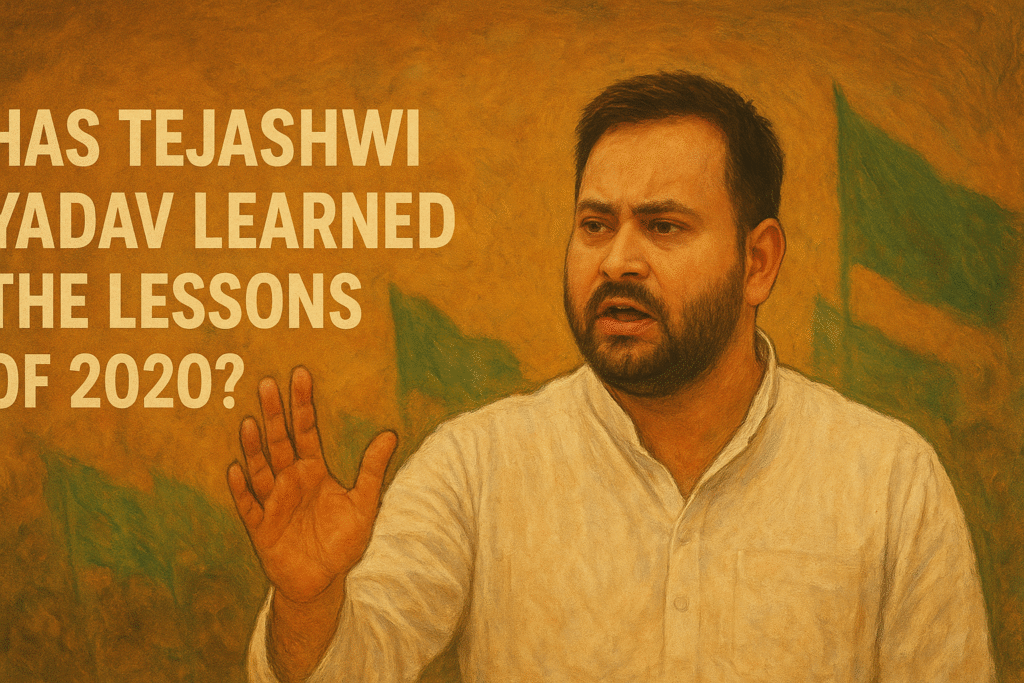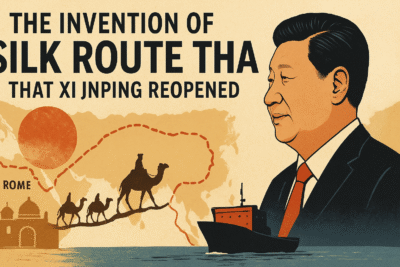
The Election Commission of India on October 6 announced the schedule for the Bihar Legislative Assembly elections: voting will take place on 6 and 11 November, with counting on 14 November. Within hours, Tejashwi Yadav released a post on X (formerly Twitter), declaring: “Bihar will vote for change … every Bihari will become CM — that is, CHANGE MAKER.”
With the electoral clock ticking, attention inevitably turns back to 2020 — the year the RJD-led Mahagathbandhan (Grand Alliance) came tantalisingly close to power. The question now, five years later, is whether Tejashwi Yadav has truly absorbed the lessons that election offered to teach.
Analysts in 2020 broadly agreed that the campaign revealed three key lessons for the young RJD leader:
- that words matter — careless remarks can alienate crucial voter blocs;
- that voters have memory — past records, controversies, and criminal charges do not vanish;
- and that politics is not a part-time profession — sustained presence and responsiveness are essential to convert sentiment into votes.
Five years on, the Bihar election of 2025 is the test of how far those lessons have shaped Tejashwi Yadav’s politics.
Revisiting 2020: The Unfinished Business
The 2020 election was one of Bihar’s tightest in recent decades. The Mahagathbandhan, led by Tejashwi, won 110 seats, falling just short of the majority mark. The RJD itself emerged as the single largest party with 75 seats, while the Congress underperformed and the NDA managed to scrape through.
Observers at the time identified several factors that blunted Tejashwi’s challenge. Some of his remarks were criticised for insensitivity, particularly those interpreted as caste-targeted. The NDA successfully revived the spectre of the “jungle raj” era, even as Tejashwi sought to project a forward-looking image. And during the 2020 migrant crisis, the Opposition was faulted for failing to seize a moment of popular discontent.
These episodes have since become the yardstick for assessing Tejashwi’s growth — his ability to learn from political mistakes and refine his craft.
Words Matter — Has the Rhetoric Softened?
In 2020, Tejashwi’s rhetoric was high-energy but occasionally sharp-edged. His description of Chief Minister Nitish Kumar as “physically and mentally tired” was perceived by some as disrespectful. In a state where seniority commands cultural reverence, such phrasing jarred with older voters.
In 2025, the tone appears consciously recalibrated. Tejashwi’s social media posts and rally speeches now favour inclusive and aspirational language — “every Bihari will become CM”, “festival of change”, “a new dawn for Bihar”. His “New Bihar” vision stresses governance, jobs, and dignity rather than invective.
That said, flashes of his combative side remain. In August, he accused Deputy Chief Minister Vijay Kumar Sinha of holding duplicate voter IDs and alleged that the government had deleted genuine electors during the Special Intensive Revision (SIR) of rolls. His charges of “scheme copying” and “administrative decay” retain the sting of old.
The balance between aggression and aspiration remains delicate. While Tejashwi’s rhetorical restraint has improved, whether he can sustain it under the heat of a campaign is still uncertain.
Voters Have Memory — Has He Outrun the Shadow of the Past?
Few legacies weigh heavier in Bihar politics than that of the “jungle raj” years. Tejashwi’s challenge since 2020 has been to prove that the RJD has changed — that governance, not grievance, defines its new identity.
He has tried to do this through policy promises and inclusive outreach. His welfare plank now includes commitments such as ₹2,500 monthly support to women under the Mai Behan Maan scheme, 200 units of free electricity, and subsidised gas cylinders. The messaging is designed to appeal beyond the RJD’s traditional base and to middle- and lower-middle-class households feeling the strain of inflation.
Caste outreach has also widened. Tejashwi has courted communities historically wary of the RJD, and his campaign framing — “what the NDA could not do in 20 years, we will in five” — seeks to turn the long incumbency of Nitish Kumar into a case for change.
Yet vulnerabilities persist. The NDA still invokes the RJD’s past to sow doubt about law and order, and reminders of criminal charges against former party figures continue to circulate in public debate. The SIR controversy has also allowed opponents to depict Tejashwi’s accusations as opportunistic rather than principled.
In short, he has worked to rewrite the RJD’s narrative, but the old story remains within reach of his rivals.
Politics as a Full-Time Profession — A More Consistent Tejashwi
Perhaps the most visible change since 2020 lies in Tejashwi’s consistency. Once derided as a part-time politician, he has maintained a far more active profile as Leader of Opposition.
He has been a regular presence across districts, addressing rallies, visiting flood-affected areas, and engaging with youth and labour groups. His interventions on electoral roll deletions, corruption allegations, and governance lapses have kept him in the headlines.
The difference from 2020 is both in frequency and tone: less reactive, more issue-oriented. His “vision document” for 2025 links his Opposition record to future promises, giving coherence to his campaign narrative.
However, sceptics point out that the RJD’s ground organisation still shows uneven strength, with local mobilisation sometimes lagging behind central messaging. Tejashwi’s high-profile appearances generate visibility, but whether that energy percolates down the constituency network remains unclear.
Even so, he has come a long way from the periods of absence that marked his early political years.
The 2025 Launch: Signals, Strategy and Stakes
Tejashwi’s immediate response to the poll announcement — “after 20 years, a grand festival will arrive that will dispel all sorrows” — symbolised an attempt to start on a positive, hopeful note. His early campaign framing emphasises change, collective empowerment, and optimism, signalling a departure from grievance-led politics.
The Mahagathbandhan, however, faces internal pressures. With new partners joining and seat-sharing talks underway, maintaining alliance coherence will test Tejashwi’s organisational diplomacy. The RJD insists on retaining its dominant position, a stance that could complicate coordination with allies.
Poll trackers suggest that Tejashwi leads as the preferred Chief Ministerial candidate, with about 34–35 per cent support, but the NDA remains marginally ahead in projected seat tallies. Analysts point out that Bihar’s contests often hinge on local arithmetic and turnout rather than state-level popularity.
The SIR controversy could also become a double-edged sword: while it lets Tejashwi claim the mantle of defending electoral fairness, sustained focus on allegations may drag him back into reactive mode.
Verdict: Lessons Learned, But Not Fully Mastered
After five years of evolution, Tejashwi Yadav stands as a more seasoned politician — but still a work in progress.
- On rhetoric, he has matured, replacing combative jibes with aspirational appeals, though the impulse to attack remains close at hand.
- On narrative, he has broadened his agenda to welfare, employment, and development, but the memory of past controversies lingers in public consciousness.
- On consistency, he has transformed from a sporadic campaigner into a visible, engaged Opposition leader, yet questions about organisational depth endure.
The 2025 campaign will reveal whether these partial shifts can translate into an electoral breakthrough. If Tejashwi sustains message discipline, manages alliances astutely, and resists rhetorical overreach, he could credibly claim to have internalised the lessons of 2020.
If not, Bihar may witness familiar patterns — different slogans, same mistakes.
Looking Ahead
As campaigning accelerates, five factors will determine whether Tejashwi’s evolution delivers results:
- Message discipline: avoiding off-the-cuff remarks that inflame caste sensitivities.
- Organisational strength: ensuring local cadres and allies mobilise effectively.
- Agenda control: setting the narrative rather than merely responding to crises.
- Development credibility: convincing voters that welfare promises are deliverable.
- Coalition unity: keeping the Mahagathbandhan’s diverse partners aligned.
Tejashwi Yadav enters 2025 not as the untested challenger of five years ago, but as a maturing contender aware that Bihar’s electorate rewards persistence and punishes complacency. Whether that awareness will be enough to tip the balance remains the defining question of this election.



